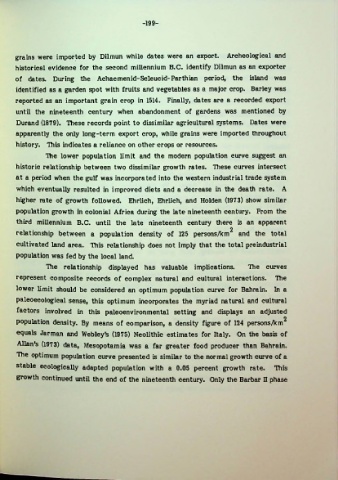Page 223 - Life & Land Use on the Bahrain Islands (Curtis E Larsen)
P. 223
-199-
grains were imported by Dilmun while dates were an export. Archeological and
historical evidence for the second millennium B.C. identify Dilmun as an exporter
of dates. During the Achaemenid-Seleucid-Parthian period, the island was
identified as a garden spot with fruits and vegetables as a major crop. Barley was
reported as an important grain crop in 1514. Finally, dates are a recorded export
until the nineteenth century when abandonment of gardens was mentioned by
Durand (1879). These records point to dissimilar agricultural systems. Dates were
apparently the only long-term export crop, while grains were imported throughout
history. This indicates a reliance on other crops or resources.
The lower population limit and the modern population curve suggest an
historic relationship between two dissimilar growth rates. These curves intersect
at a period when the gulf was incorporated into the western industrial trade system
which eventually resulted in improved diets and a decrease in the death rate. A
higher rate of growth followed. Ehrlich, Ehrlich, and Holden (1973) show similar
population growth in colonial Africa during the late nineteenth century. From the
third millennium B.C. until the late nineteenth century there is an apparent
relationship between a population density of 125 persons/km and the total
cultivated land area. This relationship does not imply that the total preindustrial
population was fed by the local land.
Tlie relationship displayed has valuable implications. The curves
represent composite records of complex natural and cultural interactions. Tlie
lower limit should be considered an optimum population curve for Bahrain. In a
paleoecological sense, this optimum incorporates the myriad natural and cultural
factors involved in this paleoenvironmental setting and displays an adjusted
2
population density. By means of comparison, a density figure of 124 persons/km
equals Jarman and Webley*s (1975) Neolithic estimates for Italy. On the basis of
Allan's (1973) data, Mesopotamia was a far greater food producer than Bahrain.
optimum population curve presented is similar to the normal growth curve of a
stable ecologically adapted population with a 0.05 percent growth rate. TTiis
growth continued until the end of the nineteenth century. Only the Barbar n phase

